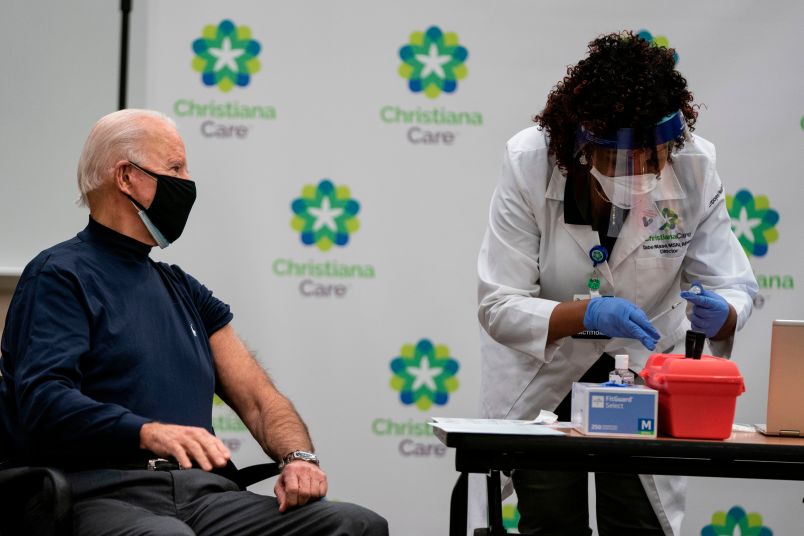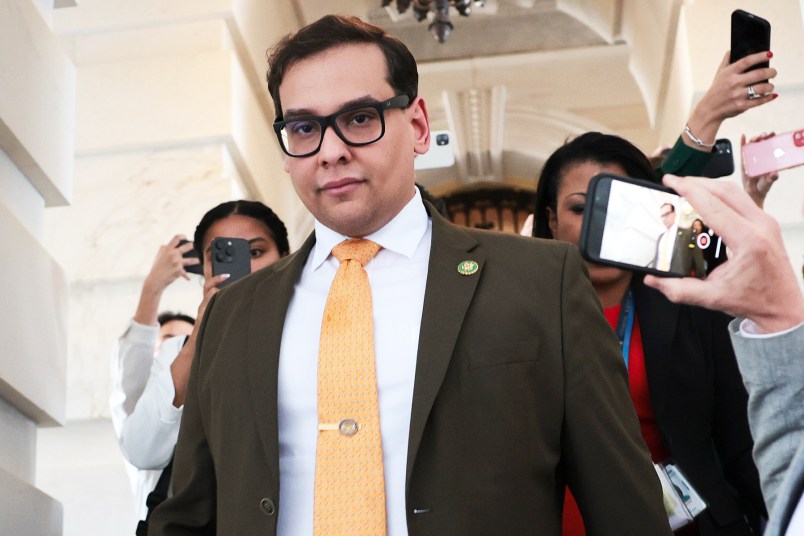The first doses of the COVID-19 vaccine are being administered, applauded on their way out of the warehouse and received with a game thumbs up by exhausted health care workers.
But amid the first bout of good pandemic-related news the country has experienced in months, the Biden administration is staring down a gargantuan task: how to take over the vaccine rollout and execute it on a mass scale.
Complicating this job is the fact that the Trump administration is promising widespread availability of the vaccine in early 2021 — without having crafted a coherent plan to make that happen.
The Trump administration’s unrealistic timeline for widespread vaccination, Democrats are increasingly acknowledging, sets the Biden administration up as a scapegoat for its successor’s failure.
Trump himself has, in spite of miscommunications around cut shipments and other early hiccups, loudly claimed that the distribution effort is going “very smoothly.”
Now the Biden transition and congressional Democrats are bracing for the political ploy by attempting to soften the ground, getting people on TV to give a more realistic timeline and writing public letters lambasting the Trump administration as directly responsible for those delays.
“Taking the vaccine from a vial into the arm of millions of Americans is one of the biggest operational challenges the United States has ever faced,” President-Elect Joe Biden said during a speech Tuesday. “We’re 300 million people. And we’re going to take many more months for that to happen.”
The Setup
The timeframe of the vaccine rollout already creates a situation in which the Trump administration’s lack of planning could be felt most sharply just as the new administration comes into office.
In the final days of the Trump administration, the government has the comparatively easy task of inoculating two static populations: frontline health care workers and nursing home residents and staff. Kaiser Family Foundations estimates that 17.6 million people fall into those categories. Once that first group has received their shots, the focus of the distribution effort broadens — meaning that the most difficult phases will take place during the start of Biden’s term.
“In this first wave … the majority of the big pushes are going to those places most capable of handling the vaccine,” said Col. Victor Suarez, a vaccine program manager at Operation Warp Speed on a webinar hosted by a medical distribution trade group.
The next phase has the potential to collide with lack of funding and exhaustion at the state level, where officials will be in charge of overseeing inventory and ensuring it makes its way into people’s arms. The $8.75 billion in the COVID-19 relief package, passed Monday night, will help, but it comes too late for states to preemptively hire more vaccinators, get a robust public education campaign off the ground and put the technological infrastructure in place to track people’s shots.
“There are 64 jurisdictions, so potentially 64 different ways of how a jurisdiction is going to choose to allocate their vaccines,” said Marion Whicker, a distribution official at Operation Warp Speed.
The Hurdles Facing The Biden Administration On Day One
But the Biden administration, even one possibly hampered by an uncooperative Republican Senate, won’t be powerless. There are specific pieces of the rollout process it can target and take over — pieces that either by the Trump administration’s indifference or active harm have gone unaddressed.
Making Sure The Vaccine Rollout Doesn’t Miss Anybody
A glaring risk in the vaccine rollout process is that the same communities that have been ravaged by the pandemic — particularly Black and Hispanic Americans — will be missed in the vaccine allocation.
That’s an area that the Biden administration, with its federal, birdseye view, can monitor.
“Only the administration can look across the whole country to see if we are reaching populations at risk, or if they’re being shut out,” Jen Kates, senior vice president of the Kaiser Family Foundation, told TPM. “They can see if some states are doing better than others, if the allocation is being carried out equitably.”
“I haven’t seen planning from the current administration to do that,” she added.
It’s a potential problem some Democrats have been cognizant of for months. What’s more is that Congressional negotiators extracted a key concession in the relief bill passed this week: $300 million was appropriated to deliver the vaccine to underserved and high-risk communities that have borne the brunt of the virus.
Ensuring That The Vaccine Is Accessible To People Of Color
Back in July, Senate Majority Leader Chuck Schumer (D-NY) and Ranking Member on the Subcommittee for Health, Education, Labor and Pensions Patty Murray (D-WA) penned a white paper outlining what the Trump administration would have to do to enable a smooth vaccine rollout.
The plan has a whole subsection devoted to ensuring that the vaccine is allocated equitably, with a special eye on the populations that have been hit hardest by the disease so far, including making sure the vaccine was widely accessible, for free, and that recipients were followed up with after receiving their shot.
That paper was published in July, but federal plans to accomplish those objectives remain vague. “Given the massive racial inequities in our health care system,” Murray told TPM, equitable vaccine distribution simply won’t happen unless it’s rolled out in a way that addresses those disparities.
“We need a coordinated, government-wide plan that engages every community, gets information out, and prioritizes the equitable distribution of safe vaccines — and Congress needs to provide the adequate funding to make that happen,” she said. “Obviously the Trump Administration fell far short of what’s needed, but I’m confident that the President-elect has selected a team that has the experience, expertise, urgency — and the right priorities — to jump in on day one to make sure that no community is left behind.”
Part of reaching those hard-hit communities is increasing public confidence in the vaccine, along with awareness about where and how to get it.
A Pew Research Survey from the beginning of December shows that only 42 percent of Black Americans say they would get the vaccine right away if it were available, as compared to over 60 percent of white and Hispanic Americans. A Kaiser report from December 15 shows sunnier numbers, with 62 percent of Black Americans reporting willingness to get the vaccine. Still though, 35 percent say they would not get it in the Kaiser study.
Studies have shown that Black Americans have a relatively high level of “physician distrust,” a natural reaction to decades of medical mistreatment dating back to slavery straight through the Tuskegee study to the alarmingly current statistic that Black mothers are three times more likely to die during or after childbirth than white ones.
It’ll take a specific education campaign, enlisting the help of community leaders and influencers, to earn trust in the vaccine. And it’s undeniably crucial — Black Americans are currently 2.8 times likelier than White Americans to die of COVID-19.
Convincing The Skeptical To Take The Shot
The need for a concerted and tailored public messaging campaign extends beyond the Black community.
Republicans have also become increasingly wary of the vaccine, perhaps in part thanks to President Donald Trump’s determination to downplay the severity of the COVID-19 pandemic, a tactic he thought would help his reelection prospects.
Kaiser’s Kates said that the organization has been polling “vaccine hesitancy” on a monthly basis, and that Republicans have been polling higher than most groups. That December 15 report showed that 42 percent of Republicans say they probably or definitely wouldn’t get the vaccine, even if it was deemed safe by scientists.
“Is the damage done? I don’t know,” Kates said. “Hopefully the new administration can reset that and governors can put aside partisanship for the sake of public health.”
Howard Koh, Obama’s HHS Assistant Secretary for Health during the H1N1 crisis, added that efforts to distribute the vaccine from centralized locations — like the Trump administration’s federal partnership with pharmacies — would only solve a small part of the problem in getting the shot into people’s arms.
“These are all issues that a single pharmacy can’t handle,” Koh said, adding that locally run public information campaigns would be necessary in communities skeptical of the vaccine.
“Outreach, communication and education are really important to raise trust, which right now is really having some challenges,” Koh added.
The Biden administration will be able to fill that vacuum of federal messaging both for specific communities, and broadly with consistent, transparent messaging about the safety of the vaccine and the importance of getting it.
Congress Can Finish The Job
Finally, Biden may be able to breathe fresh air into funding negotiations that, until this week, were stalemated for a whopping eight months.
The $900 billion COVID-19 relief bill will certainly alleviate some of the more frightening short-term concerns, like the end-of-year cliffs for unemployment insurance and the rent moratorium. But it only doles out $8.75 billion for vaccine distribution, with $4.5 billion of that going right to the states. That won’t be enough for the many states who have seen their budgets and public health departments hollowed out by the pandemic. Republicans axed the $160 billion in state and local aid proposed by Democrats as a deal-breaker to the caucus.
Another package will likely be needed, a feat possibly made harder by the recent passage of this one, which was spurred by the government funding deadline and will give lawmakers some cover.
“He’ll probably have to work hard across the aisle to get additional funding,” Kates mused. (The exact makeup of the Senate will not be known until the Jan. 5 Georgia runoffs.)
Koh added that the amount of work that still needs to be done is staggering.
“Vaccination systems take years to build and the existing ones need to be upgraded and adjusted for any new threat,” Koh said. “So this takes our existing infrastructure — which is overstretched at baseline — and asks health professionals who are already working 24/7 to ramp it up.”
“So much of this could have been prevented and should have been prevented,” he added.



